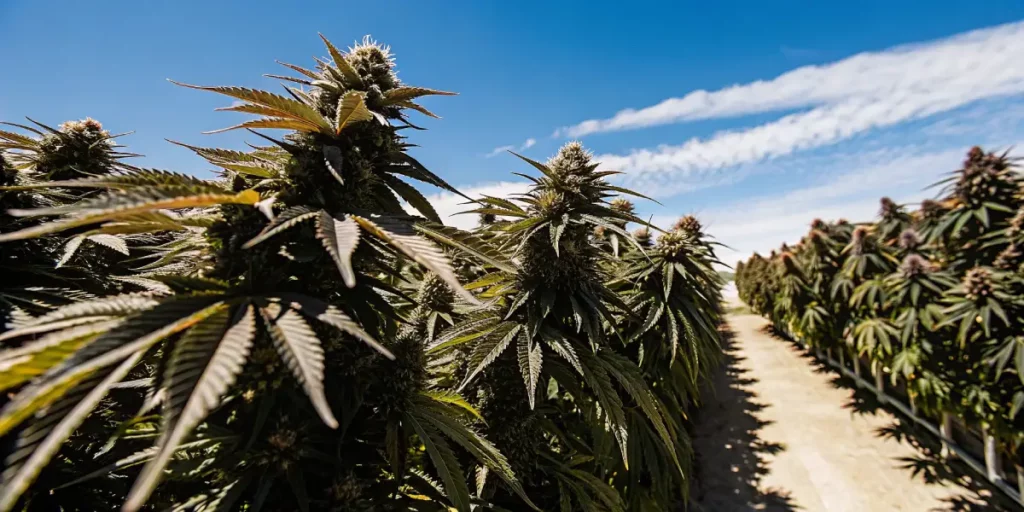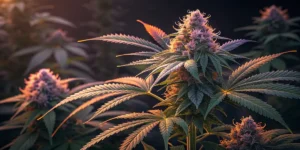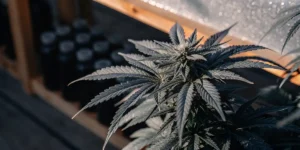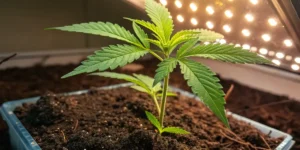Kush Mintz, a balanced hybrid strain known for its refreshing mint flavor and potent effects, has become a favorite among cannabis cultivators. Growing this strain requires a blend of patience and careful attention to detail. Start with selecting high-quality seeds from a reputable supplier to ensure the best genetic material for your plants. This variety thrives in both indoor and outdoor setups, making it versatile for various growing environments. However, maintaining optimal conditions is key to achieving high yields and potent buds.
For indoor cultivation, create a controlled environment with a consistent temperature range between 70-80°F (21-27°C) and humidity levels maintained around 40-50%. This strain does well with a light schedule of 18 hours on and 6 hours off during the vegetative stage, transitioning to a 12/12 light cycle for flowering. Invest in quality grow lights and ensure adequate airflow using fans or ventilation systems. Regular monitoring of pH levels in your growing medium, ideally between 6.0 and 6.5, will help prevent nutrient lockout and ensure your plants absorb nutrients efficiently.
When growing outdoors, select a location that provides ample sunlight, ideally 6-8 hours of direct exposure per day. This variety prefers well-draining soil rich in organic matter, so amending your garden plot with compost or well-rotted manure can enhance soil fertility. Protect outdoor plants from pests by using organic deterrents or beneficial insects, and consider staking larger plants to support heavy bud formation during the flowering stage. Monitoring the weather is crucial, as extreme conditions can stress the plants, affecting growth.
Regular feeding with a balanced cannabis nutrient solution is essential for maximizing growth. During the vegetative phase, focus on nutrients high in nitrogen, while in the flowering phase, phosphorus and potassium become more critical. Water your plants adequately but avoid overwatering, allowing the top inch of soil to dry out between watering sessions. Pruning and training techniques such as topping or low-stress training (LST) can help improve light penetration and increase yields, especially in indoor setups.
Harvesting at the right time is vital to achieving the strain’s signature potency and flavor. Watch for trichomes turning milky white with a hint of amber, which indicates peak THC levels. Carefully trim, dry, and cure your buds to preserve their aromatic profile and enhance the smoking experience. With dedication and attention to detail, cultivating this variety can be a rewarding endeavor, providing a generous yield of high-quality cannabis. m
Strain Overview: Traits, Effects & Genetics
The kush mintz strain is a unique and sought-after cannabis variety that has garnered attention for its distinctive traits and potent effects. Known for its remarkable genetic lineage, this indica-dominant hybrid arises from a cross between Bubba Kush and Animal Mints. This blend gives it notable characteristics, which include a robust minty aroma coupled with earthy undertones. Cultivators and cannabis enthusiasts alike appreciate its dense, frosty buds that showcase a rich palette of green, purple, and orange hues, making it visually appealing as well.
In terms of effects, this strain offers a versatile experience that can accommodate both recreational and medicinal uses. Users often describe the initial impact as an uplifting euphoria, which gradually transitions into a full-body relaxation. This makes it a great choice for those looking to alleviate stress and anxiety, as well as those suffering from muscle tension or chronic pain. The strain’s calming effects are also accompanied by a sharpened mental clarity, making it suitable for creative endeavors or social situations without causing excessive sedation.
Genetically, it benefits from the robust genetics of its parent strains, resulting in a plant that is both resilient and high-yielding. Its indica dominance ensures a manageable growth height, making it ideal for indoor cultivation. Furthermore, this variety is relatively resistant to pests and molds, thanks to its hardy nature, which appeals to both novice and experienced growers. The strain typically flowers within 8 to 10 weeks, providing a rewarding harvest adorned with aromatic buds. When grown with care, it not only promises quality and potency but also an enriched sensory experience for those who partake.
Optimal Environment to Grow Kush Mintz Successfully
Kush Mintz is a popular cannabis strain known for its unique minty fragrance and potent effects. To cultivate this strain successfully, it is imperative to create an optimal growing environment. Start by ensuring a controlled indoor setting, which allows better regulation of temperature, humidity, and light. The ambient temperature should ideally be kept between 70°F to 80°F during the day and no lower than 65°F at night. An oscillating fan can help maintain air circulation, which is vital for preventing mold and promoting strong, healthy plant growth.
Light is a critical component in the successful cultivation of this cannabis strain. During the vegetative stage, a light cycle of 18 hours on, followed by 6 hours off, is recommended. Transition to a flowering stage requires adjusting the light to a 12/12 cycle. High-quality LED grow lights are preferred as they provide the necessary light spectrum more efficiently, contributing to a higher yield. Ensure the plants are not too close to the light source to avoid overheating and light burn.
Humidity and air filtration are also important environmental factors for this variety. During the vegetative phase, maintain a relative humidity of around 40% to 60%. Drop this to about 30% to 40% during the flowering stage to prevent mold and mildew, which can compromise the quality of the buds. Use a reliable humidity meter to track these levels closely. Proper air filtration with a carbon filter system will help to manage odors and keep the environment fresh, as well as reduce the risk of pest invasions.
Soil quality and water pH balance are critical, as they directly affect nutrient uptake. Use a well-aerated potting mix rich in organic matter and maintain the soil pH level between 6.0 and 6.5. Overwatering can lead to root rot; hence, it is essential to let the soil dry to a certain extent between waterings. Regularly check the pH of the water being used to ensure it stays within an optimal range, facilitating healthy growth and robust yields.
Nutrient management is crucial for the development of this strain. During the vegetative phase, provide nutrients that are high in nitrogen to support healthy leaf and stem growth. As the plants transition to the flowering stage, switch to a fertilizer mix with higher levels of phosphorus and potassium to enhance bud development and potency. Remember to flush the plants with pure water during the last few weeks before harvest to improve the flavor and smoothness of the final product.
Grow Room Setup for kush mintz Plants
Setting up a grow room for kush mintz, a popular hybrid cannabis strain known for its minty aroma and potent effects, requires careful consideration of several environmental factors. First and foremost, it’s important to select an adequately sized space that allows for optimal plant growth. A grow tent is often ideal, as it enables precise control over the growing conditions and light exposure. Ensure the space is clean and sealed to prevent pests and diseases. Proper ventilation is crucial; installing a quality exhaust fan and carbon filter helps mitigate odor and maintain air circulation, which in turn supports healthy plant development and pest prevention.
Lighting plays a pivotal role in the growth and health of these cannabis plants. High-Intensity Discharge (HID) lights, such as Metal Halide (MH) for the vegetative stage and High-Pressure Sodium (HPS) for the flowering stage, are commonly used. However, energy-efficient LED grow lights are gaining popularity for their ability to provide a full spectrum of light, offer cooler operation, and reduce electricity costs. Position lights at an appropriate distance from the canopy to avoid light burn while ensuring sufficient light penetration. Adjustable light hangers, timers, and reflective walls in the grow room enhance the efficiency of the lighting setup.
Temperature and humidity control are two of the most critical aspects of creating a conducive environment for optimal plant growth. During the vegetative stage, maintain temperatures between 70-85°F (21-29°C) and humidity levels between 40-60%. As the plants transition to the flowering stage, reduce temperature slightly to 65-80°F (18-27°C) and humidity to 35-50%. Utilizing heaters, air conditioners, humidifiers, and dehumidifiers as necessary ensures these conditions remain stable and supportive of plant health. Consistently monitoring these parameters with a reliable hygrometer and thermostat is essential for maintaining the ideal growing environment.
Besides temperature and humidity, the medium and nutrients you choose will significantly impact your plants’ success. A quality soil mix or soilless medium like coco coir works well, providing good drainage and root aeration. Supplying a balanced nutrient solution rich in nitrogen during the vegetative stage and phosphorus and potassium during the flowering stage supports robust growth and maximizes yields. Regularly check pH levels of the water and nutrient solution, aiming for a range of 6.0-7.0 to prevent nutrient lockout and ensure optimal nutrient absorption.
Indoor Growing Tips
When growing Kush Mintz indoors, it’s essential to provide an environment that mimics its natural habitat to achieve optimal results. Start with ensuring that your grow room or tent has a consistent temperature range between 70-80°F (21-27°C) during the day and slightly cooler at night. Maintaining the right temperature is crucial as it promotes vigorous growth. Using a thermostat-controlled heater and an AC unit can help maintain these temperatures. Additionally, this strain thrives in a humidity-controlled environment with a relative humidity of 40-60% during the vegetative stage, reducing to 30-40% during flowering to prevent mold and mildew.
Lighting is another critical factor in growing this indoor variety successfully. During the vegetative stage, a light cycle of 18-6 hours is recommended and should be adjusted to 12-12 hours for the flowering stage to stimulate bloom production effectively. High-quality LED grow lights or HID lights are often preferred for their intensity and full spectrum capabilities, promoting robust plant health and enhancing the terpene profile, which is a notable characteristic of this strain.
Soil choice and nutrition are pivotal in supporting the growth of these plants. Use high-quality organic soil that is rich in nutrients, or opt for a well-balanced hydroponic solution if you’re pursuing soilless growth. This variety requires a nutrient-rich diet, particularly phosphorus and potassium, during its flowering phase to encourage maximum bud production. Ensure a proper pH level for soil (6.0-6.5) or hydroponics (5.5-6.0) to facilitate nutrient uptake. Regular monitoring and amendments might be necessary to keep nutrient levels optimal and prevent nutrient lockout.
Pruning and training techniques like topping, low-stress training (LST), or scrogging can significantly benefit your indoor cultivation. These practices encourage bushier plants and expose more bud sites to light, ultimately increasing yields. Be gentle with plant training to avoid undue stress that can impede growth. Regularly inspect your plants for pests or disease, acting swiftly with organic pesticides or fungicides as necessary to maintain plant health through its growing cycle.
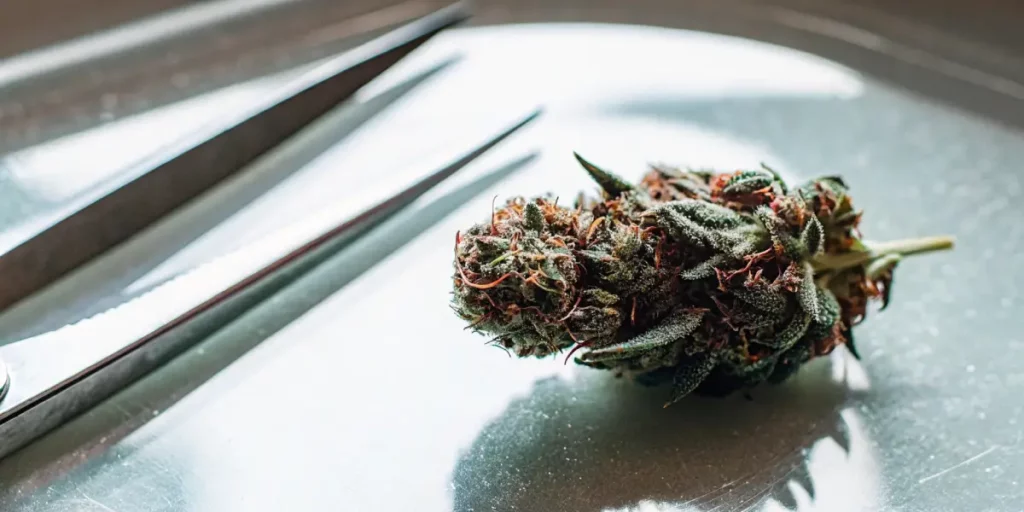
Outdoor Growing Tips
Kush Mintz, a popular hybrid strain known for its balanced effects and rich minty aroma, can thrive in the great outdoors if cultivated with care and attention. The first step to a successful outdoor grow is selecting the right location. This strain prefers a sunny spot with plenty of direct sunlight throughout the day. Ensure your chosen location is well-drained, as standing water can lead to root rot. Preparing the soil by mixing in organic compost will provide the nutrients necessary for robust growth.
Once your site is prepared, timing your planting is crucial. As this variety generally has a flowering period of 8 to 10 weeks, the seeds or seedlings should be introduced to the outdoor environment after the last frost has passed and temperatures are consistently above 60°F (16°C). This typically means late spring for many regions. Providing your plants with adequate space for growth is also essential, with each plant ideally spaced at least three feet apart to ensure adequate airflow and light penetration.
Regular maintenance includes consistent watering, especially during dry spells, but take care not to overwater, as this strain prefers slightly dry conditions. Feeding your plants with a balanced fertilizer throughout their growth stages will support their nutritional needs. During the vegetative stage, higher nitrogen levels promote healthy foliage growth, while a bloom booster rich in phosphorus and potassium enhances flowering.
Pest control is another important aspect of outdoor growing. Keep an eye out for common cannabis pests such as aphids and caterpillars, and consider natural deterrents like neem oil or introducing beneficial insects like ladybugs. Employing these strategies will help protect your plants from potential infestations. Regular pruning and trimming of the lower branches will also improve airflow and minimize disease risks, enhancing the overall health and yield of your crop.
Lastly, be mindful of the plant’s flowering signs. Monitoring trichome development is a good indicator of harvest readiness. When most trichomes turn a milky white with few amber ones, it’s time to harvest for optimal potency and flavor. With the right care and attention, this variety can produce a rewarding outdoor harvest, offering growers the unique satisfaction of cultivating a high-quality cannabis strain.
How to Germinate & Propagate Kush Mintz
The first step in cultivating Kush Mintz, a popular cannabis strain known for its minty fresh flavor and relaxing effects, involves germination. Begin by selecting high-quality feminized seeds to ensure a higher likelihood of successful female plant growth. Start with the paper towel method, a reliable and straightforward approach. Moisten a few sheets of paper towels and place your seeds between them. Ensure that the towels are damp but not soaking wet, as excess water can lead to rot.
Once the seeds are nestled between the moist paper towels, place them inside a sealable plastic bag or between two plates to create a small, dark, and humid environment. This mimics the natural earthy conditions, promoting seed opening. Store the seeds in a warm, dark location such as a closet or drawer, maintaining a temperature range between 70-85°F (21-29°C). Check daily to ensure that the towels remain damp and that the seeds are sprouting. This process should typically yield results within 1-4 days.
As soon as the seeds develop visible roots, they’re ready to be transferred into a growing medium for propagation. Using small pots filled with a light, aerated soil mix or a specific seedling starter medium provides a nurturing environment for young seedlings. Make a small hole in the soil about half an inch deep and place your germinated seed root-down, then gently cover it with soil. Carefully water the soil, being cautious not to dislodge the seed.
The next phase is ensuring the right humidity and light exposure to foster healthy growth. Employ LED grow lights or T5 fluorescent lights to provide gentle illumination for 18-24 hours a day. Keeping humidity levels between 60-70% helps prevent excessive water loss during this delicate stage. Ensure good airflow to avoid mold and pests, and monitor the seedlings closely for signs of stress or nutrient deficiency.
Once your seedlings have developed well-established roots and a few sets of leaves, they are ready to be repotted or placed in a more permanent home. Transplant them carefully, maintaining root integrity, into larger containers or directly into your outdoor garden when the risk of frost is no longer present. With patience and care, your plants will soon flourish, providing a rewarding yield.
Vegetative Stage: Nurturing Your kush mintz Plants
During the vegetative stage, your kush mintz plants focus on developing robust stems and a healthy leaf structure to support future flowering. At this stage, attention to environmental factors such as light, temperature, and humidity is crucial. Ensure your grow space offers ample light—ideally 18 hours of light followed by 6 hours of darkness daily. Proper lighting encourages vigorous growth and helps your plants develop the strong roots and branches necessary for a successful flowering stage.
Soil quality and nutrients are also critical during the vegetative stage. Your plants require soil that drains well, with a pH level between 6.0 and 7.0. Regularly supply your plants with nutrients high in nitrogen, which is essential for leaf development. A balanced N-P-K (nitrogen-phosphorus-potassium) ratio can optimize growth, and you should incorporate nutrients every couple of weeks, observing their reactions to avoid nutrient burn or deficiencies.
Watering is another important aspect of nurturing your plants. Overwatering can suffocate the roots, while underwatering may stunt growth. The best approach is to water thoroughly but infrequently, allowing the top inch of soil to dry out between waterings. Pay attention to the leaves: yellowing can indicate overwatering, while wilting suggests your plants need more water. Maintain consistent moisture for optimal plant health.
Lastly, remember that regular pruning and training are vital for controlling the structure and optimizing light exposure. Remove lower branches and leaves that do not receive adequate light to promote airflow and resource distribution to the upper part of the plant. Low-stress training (LST) can be particularly effective, helping to shape the plant for an even canopy and maximize yield potential. By adhering to these guidelines, you’ll set the foundation for a bountiful harvest.
Flowering: What to Expect
When growing Kush Mintz, one of the most popular strains among cannabis enthusiasts, understanding the flowering stage is crucial for a successful harvest. This strain is known for its robust growth and distinctive aroma, but it requires careful attention during flowering. The flowering period typically lasts between 8 to 10 weeks, depending on the environmental conditions and the phenotype of the plant. As your plants begin to flower, you’ll notice a marked increase in the development of buds, accompanied by a rich, minty scent that becomes more pronounced as the weeks progress.
During the flowering stage, it’s essential to maintain optimal conditions to ensure your plants thrive. This variety demands a consistent light cycle, usually 12 hours of light followed by 12 hours of complete darkness. This schedule mimics the natural approach of flowering cannabis in nature. Keep a close eye on the temperature and humidity levels within your grow space. Aim for a temperature between 68 and 77 degrees Fahrenheit and humidity levels that don’t exceed 50% to prevent mold and mildew from affecting the developing buds.
As the flowering stage advances, feeding the plants the appropriate nutrients becomes even more critical. Gradually switch to a nutrient formula high in phosphorus and potassium, essential elements for bud development and resin production. Avoid over-fertilizing, which can lead to nutrient burn or lockout, both detrimental to the plant’s health. You’ll observe the buds thickening and the trichomes, the tiny resin glands, becoming more visible and milky, which is a good indicator of the potency levels you’re aiming for.
Lastly, be vigilant for any signs of pests or diseases that could hinder your harvest. Regularly inspect your plants for any infestations and take preventive measures as necessary. As you near the end of the flowering phase, flushing your plants with pure water for a week or two can help remove any residual nutrients, enhancing the final taste and quality. With patience and meticulous care, the flowering period can be a highly rewarding experience, offering abundant yields of aromatic, potent buds.
Feeding: Fertilizers & Nutrient Schedule
Feeding Kush Mintz cannabis plants properly is crucial for ensuring healthy growth and maximizing yield. Careful attention must be paid to the type and quantity of nutrients provided, as well as the timing of their application. This cannabis strain, like many others, requires a balanced diet of macronutrients and micronutrients. Macronutrients such as nitrogen, phosphorus, and potassium are essential for fundamental processes like growth and flowering. Meanwhile, micronutrients like calcium, magnesium, and sulfur play supporting roles that enhance plant health.
During the vegetative phase, a nutrient mix higher in nitrogen is recommended. This will support the plant’s rapid growth as it develops leaves and structural biomass. A typical vegetative nutrient formula might consist of a 4:2:3 ratio of nitrogen (N), phosphorus (P), and potassium (K). Begin with a lower concentration, increasing gradually based on the plant’s responsiveness. It is also wise to monitor plants for signs of over-fertilization, such as leaf burn, and reduce nutrient concentration accordingly.
As the plant transitions into the flowering stage, the nutrient needs shift significantly. At this point, the focus should be on increasing phosphorus and potassium to enhance bud development. Utilize a feeding schedule that adjusts the N-P-K ratio to a 1:3:4 formulation to promote larger, denser buds. During flowering, flush the plants with plain, pH-balanced water regularly to prevent nutrient buildup, which can affect flavor and potency negatively.
Consistent monitoring of pH levels is essential throughout the growing process to ensure effective nutrient absorption. The optimal pH range for soil cultivation is between 6.0 and 7.0, while hydroponic systems should maintain a slightly lower pH range, around 5.5 to 6.5. Regular testing and adjustment will help prevent nutrient lockout symptoms, ensuring that the plants have unfettered access to their required dietary elements.
Incorporating a reliable nutrient schedule tailored for this strain can make a significant difference in the outcome of your crop. Establish a twice-weekly feeding routine during the vegetative stage, adjusting to a thrice-weekly schedule during flowering as the plant’s nutrient demands intensify. Remember, every growth environment is unique, so be prepared to adjust these guidelines based on the specific conditions of your grow operation.
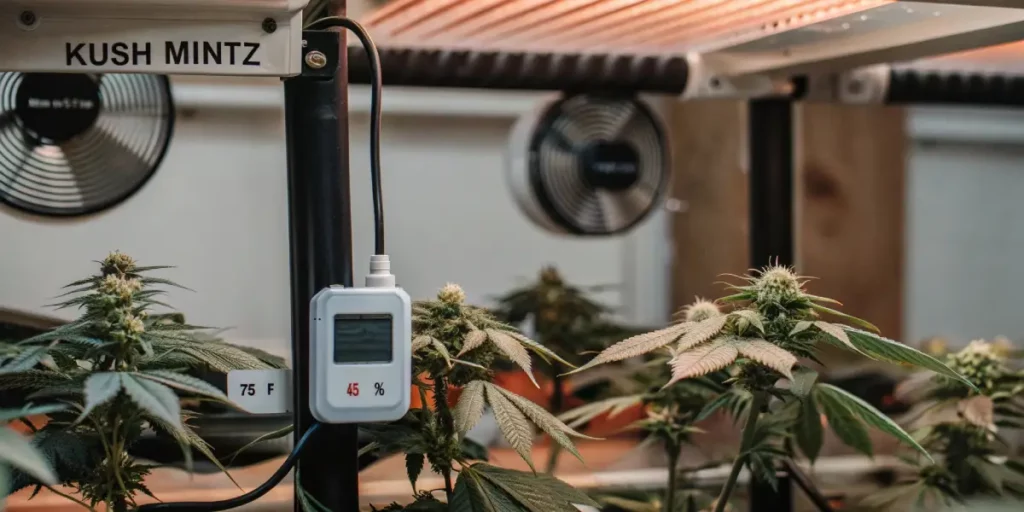
Pest and Disease Prevention for Healthy Cannabis Plants
Growing healthy Kush Mintz cannabis plants requires a proactive approach to pest and disease prevention. These plants, known for their potent minty aroma and uplifting effects, can be vulnerable to various pests and diseases. Taking preventative measures early on can help ensure a healthy and bountiful harvest. One of the first steps in prevention is maintaining a clean grow environment. Regularly sterilizing tools and cleaning the growing area helps minimize the risk of introducing harmful pathogens and pests. Additionally, ensuring proper air circulation and temperature control can prevent mold and mildew that thrive in stagnant, humid environments.
Another critical aspect of pest prevention is regularly monitoring your plants for any signs of infestation. Weekly inspections of the leaves, stems, and soil surface can help detect pests like spider mites, aphids, and whiteflies early. Utilizing yellow sticky traps can also serve as an effective measure to trap and identify flying insects. Biological control methods, such as introducing beneficial insects like ladybugs and predatory mites, can naturally curb pest populations without the need for chemical interventions. Maintaining the health of the plant through adequate nutrition and care also strengthens its natural defenses against pests.
Besides to pests, fungal diseases can pose a significant threat to cannabis plants. Ensuring proper watering practices by avoiding overwatering and providing well-draining soil can reduce the risk of root rot and other soil-borne diseases. Using fungicides as a preventive measure should be done cautiously, opting for organic or plant-based options to minimize potential harm to the environment. Regular pruning of the lower branches and leaves can increase airflow and light penetration, further helping to reduce the risk of mold and mildew growth. By integrating these strategies into your cultivation routine, you can create a robust defense system against pests and diseases, ensuring that your Kush Mintz plants thrive throughout their growth cycle.
Harvesting & Drying Kush Mintz the Right Way
Harvesting Kush Mintz at the optimal time is crucial to preserving its flavor profile and potency. Begin by observing the trichomes on your plants; they should be a cloudy white color with some turning amber, indicating the peak time for harvesting. Additionally, the pistils should have turned from white to a darker color, such as orange or brown. Using sharp, sterilized scissors, carefully trim the branches, making clean cuts to avoid plant stress. Be gentle during this process to prevent damage to the valuable buds.
Once harvested, it is important to lightly trim the excess fan leaves to prepare the buds for drying. Trimming helps in achieving a smoother smoke and enhances the overall appeal of the buds. An initial wet trim can aid in reducing moisture content and preventing mold. However, some growers prefer to trim after drying to preserve terpenes and cannabinoids by allowing the plant to dry slowly with the leaves still intact. Whichever method you choose, carefully handle the buds to avoid unnecessary knocking off of trichomes.
The drying phase is critical for preserving the quality of the buds. Hang the trimmed branches upside down in a room with a controlled environment, aiming for humidity levels around 50-60% and a temperature range of 60-70°F (15-21°C). Ensure there is adequate air circulation to prevent mold, but avoid direct fans on the buds, which can cause uneven drying. Typically, drying takes 7-14 days, but ensure that the stems snap rather than bend to confirm they are adequately dried.
Once dried, the final step involves curing, a process that truly enhances the flavors and potency of the cannabis. Place the dried buds in airtight glass jars, filling them about 75% full. Store these jars in a cool, dark place, opening them daily for a week to release excess moisture and allow fresh air in. This process, known as burping, should be done for about two weeks to a month, unlocking the full potential of your Kush Mintz harvest.
Strain Type: Indica, Sativa or Hybrid?
Kush Mintz is a hybrid cannabis strain, creatively blending the nuanced characteristics of both indica and sativa plants. As a hybrid, it finds its genetic lineage rooted in the popular strains Bubba Kush and Animal Mints, offering a balance that attracts growers and users alike. The meticulous breeding of this hybrid results in a plant that embodies the potency and physical attributes of indica traits while also showcasing some of the cerebral and uplifting effects associated with sativa strains. This dual-profile makes it an ideal choice for those seeking to experience the best of both worlds in one strain.
In terms of its physical growing characteristics, this indica-dominant hybrid typically exhibits traits that growers might expect. Cultivators can anticipate a relatively short and bushy plant structure, which makes it suitable for indoor cultivation where space can be limited. Despite its indica-like growth pattern, this variety can surprise cultivators with its substantial yield, a trait often appreciated from its sativa lineage. Flowering times generally range around 8 to 9 weeks, echoing the adaptability and efficiency one might expect from a hybrid.
The effects further underscore its hybrid nature. Users often report a potent relaxation experience akin to what is common with indicas, making it an excellent choice for unwinding and evening use. However, it equally offers an uplifting mental stimulation characteristic of sativa strains. The hybrid balance can help inspire creativity and focus without succumbing entirely to sedation. This versatile profile is reflected in its diverse usage, providing both recreational and potential therapeutic uses for those dealing with stress, mood fluctuations, or mild physical discomfort.
Why Grow Kush Mintz? Key Benefits for Cultivators
Kush Mintz is an increasingly popular strain among cannabis cultivators due to its unique genetic composition and desirable effects. This hybrid plant is born from the fusion of Bubba Kush and Animal Mints, offering a balanced indica-sativa profile that attracts both growers and consumers. Cultivators favor this strain for its robust growth potential, as it thrives in varied environments and adapts well to different growing techniques. Its resilience against common pests and molds makes it an excellent choice for both novice and experienced growers seeking a reliable and rewarding crop.
One of the standout attributes of this variety is its impressive yield. When grown under optimal conditions, cultivators can expect a substantial harvest of dense, resin-rich buds. Moreover, the flowering time ranges between 8 to 9 weeks, which is relatively short, allowing for a quicker turnover compared to other strains. This fast flowering period maximizes efficiency and profitability, making it a financially appealing option for commercial growers aiming to maximize their production cycles within a year.
Apart from its growth characteristics, this strain is particularly valued for its aromatic and flavor profiles. It features a delightful mix of earthy, minty, and subtly sweet undertones that cater to consumers who appreciate complex flavor experiences. Along with its sensory appeal, the strain offers a potent and balanced effect, providing a calming body high accompanied by an uplifting cerebral buzz. This combination makes it attractive to both recreational users and medical patients, ensuring steady demand in the market. Consequently, cultivating this variety can be a lucrative endeavor for those looking to capitalize on its multi-dimensional appeal.
Potential Challenges When Growing Kush Mintz
Growing this particular cannabis strain can be a rewarding experience, but it is not without its challenges. One of the primary difficulties lies in managing the plant’s specific climate requirements. This variety thrives best in a controlled environment with consistent temperatures ranging between 70-80°F (21-27°C) during the day and slightly cooler at night. High humidity levels, especially during the flowering stage, can lead to mold and mildew development, so maintaining the right balance of humidity is crucial. Cultivators must invest in quality ventilation and dehumidification systems to mitigate these risks effectively.
Another challenge is nutrient management, which is critical for healthy growth. This strain has a unique nutrient profile and can be sensitive to overfeeding, particularly during its vegetative phase. Over-fertilization can lead to nutrient burn, characterized by browning leaf tips and stunted growth. Growers should be cautious with nutrient concentrations, regularly monitor the pH levels in the soil or growing medium (ideally maintaining a range of 6.0-6.5), and adjust their fertilization schedules based on the plants’ specific needs at different growth stages.
Additionally, pest control can present significant obstacles. Like many cannabis strains, this variety is susceptible to common pests such as spider mites, aphids, and whiteflies. These pests can quickly damage the plants if not dealt with promptly. Establishing a proactive integrated pest management strategy is vital, incorporating regular inspections and the use of organic pest control methods to prevent infestation without harming the plants or environment. Monitoring for early signs of pest invasion will also enable timely interventions, reducing the potential for extensive damage.
Lastly, this strain can grow to medium heights with dense flowering nodes, making pruning and training techniques necessary to optimize airflow and light exposure.Failure to regularly trim excess foliage can lead to overcrowding and poor light penetration, hampering bud development and increasing the risk of disease. Employing methods such as topping, LST (Low Stress Training), and defoliation can aid in promoting an even canopy and healthier growth overall. Diligent attention to these potential challenges will significantly enhance the likelihood of a successful Kush Mintz harvest.
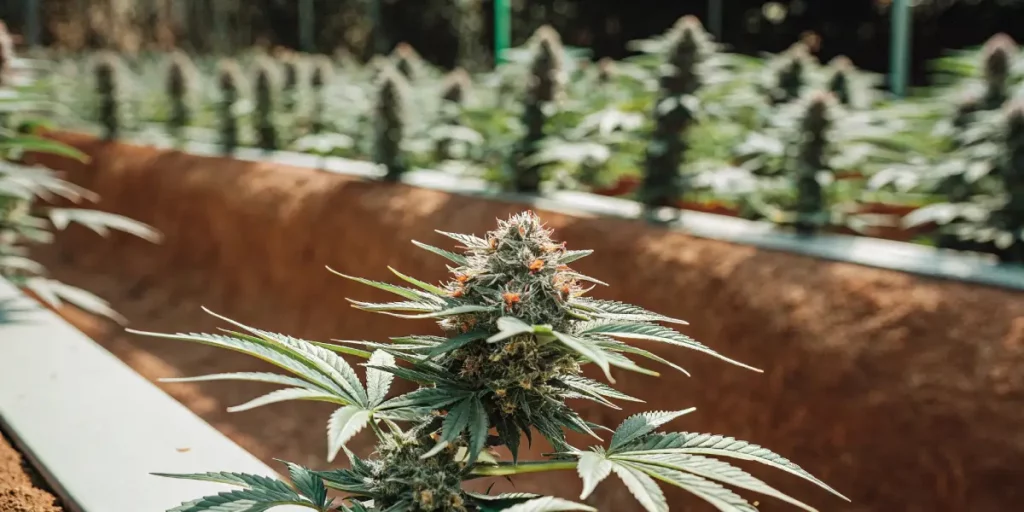
Is Kush Mintz Worth Buying? Here’s What You Need to Know
Kush Mintz is a hybrid cannabis strain that has garnered significant attention for its unique blend of flavors and potent effects. A crossbreed of Bubba Kush and Animal Mints, this strain is known for its balanced nature, providing both a profound body high and a cerebral uplift. The intriguing lineage of this cannabis strain offers a rich profile that makes it an attractive option for both recreational and medicinal users. However, before deciding to purchase this variety, it’s important to understand its attributes and what it might bring to your cannabis experience.
One of the primary highlights is its distinctive flavor, which combines earthy and minty notes with a hint of sweetness. This complex taste profile makes it a standout choice for connoisseurs looking for something beyond the typical cannabis flavors. Additionally, its aroma carries hints of coffee and cookies, offering a rich sensory experience that extends beyond taste alone. For those who appreciate strains with an exceptional flavor and aroma, this variety is certainly worth considering.
In terms of effects, this strain is well-regarded for offering both mental and physical benefits. It’s celebrated for its ability to induce a state of relaxation and euphoria, which can be valuable for stress relief in recreational users and symptom management in medical patients. The hybrid nature ensures that the effects are balanced, providing relaxation without excessive sedation and mental stimulation without causing anxiety. This equilibrium makes it suitable for various times of day, pending individual preferences and tolerance levels.
When evaluating whether this strain is worth buying, potential growers should consider the cultivation requirements as well. It thrives in a controlled indoor environment where temperature and humidity can be carefully managed. It typically flowers within eight to nine weeks and has a moderate yield, which complements its robust potency. Despite being slightly more demanding in terms of growing conditions, the effort can be worthwhile due to the high quality of the final product, making it a potentially rewarding investment for experienced and dedicated growers.
FAQs
What is Kush Mintz cannabis strain?
Kush Mintz is a hybrid cannabis strain that has gained popularity for its balanced effects and unique flavor profile. It is a cross between the classic Bubba Kush and Animal Mints strains. The strain is known for its minty and earthy aroma, which is often accompanied by hints of coffee and cookies. It offers a potent high that combines the calming effects of an indica with the uplifting sensations of a sativa.
What are the effects of Kush Mintz?
Kush Mintz is known for its balanced effects that can be both physically relaxing and mentally stimulating. Users often report experiencing an initial surge of euphoria and creativity, making it ideal for artistic endeavors or social gatherings. As the high progresses, you may feel a deep sense of relaxation that can help relieve stress and tension. Similar to strains like Special Kush 1, it’s often used to alleviate symptoms of anxiety, depression, and pain.
What are the terpene profiles found in Kush Mintz?
The terpene profile of Kush Mintz is a complex blend that contributes to its distinctive flavor and aroma. The primary terpenes are limonene, beta-caryophyllene, and linalool. Limonene adds a citrusy note and provides uplifting effects, while beta-caryophyllene offers a spicy, peppery aroma and has anti-inflammatory properties. Linalool, known for its floral scent, adds calming effects to the strain.
How should Kush Mintz be consumed for best results?
Kush Mintz can be consumed in various ways depending on personal preference. Smoking or vaping the flower is popular for immediate effects and flavor appreciation. Alternatively, consuming edibles infused with Kush Mintz can offer a longer-lasting high, though effects take longer to onset. As with any cannabis product, starting with a small dose and gradually increasing is recommended to gauge individual tolerance levels.
What are the potential side effects of using Kush Mintz?
While Kush Mintz is generally well-tolerated, some users may experience side effects, particularly if consumed in large quantities. Common side effects include dry mouth and dry eyes, which can usually be relieved with hydration and appropriate eye drops. Less commonly, users may experience dizziness or mild paranoia, especially if they are new to cannabis or sensitive to THC. It’s important to consume responsibly and be mindful of dosage.

